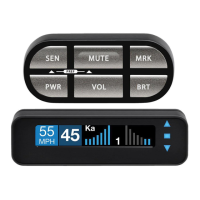16
How Radar Works
Trac radar, which consists of microwaves, travels
in straight lines and is easily reected by objects
such as cars, trucks, even guardrails and overpasses.
Radar works by directing its microwave beam down
the road. As your vehicle travels into range, the
microwave beam bounces o your car, and the
radar antenna looks for the reections.
Using the Doppler Principle, the radar
equipment then calculates your speed by
comparing the frequency of the reection of your
car to the original frequency of the beam sent out.
Trac radar has limitations, the most
signicant of these being that it typically can
monitor only one target at a time. If there is more
than one vehicle within range, it is up to the radar
operator to decide which target is producing the
strongest reection. Since the strength of the
reection is aected by both the size of the vehicle
and its proximity to the antenna, it is dicult for the
radar operator to determine if the signal is from a
sports car nearby or a semi-truck several hundred
feet away.
Radar range also depends on the
power of the radar equipment itself.
The strength of the radar unit’s beam
diminishes with distance.
The farther the radar has to
travel, the less energy it has for
speed detection.
Because intrusion alarms and motion sensors often
operate on the same frequency as X, and K-band
radar, your detector will occasionally receive
non-police radar signals.
Since these X-Band transmitters are usually
contained inside of a building, or aimed toward the
ground, they will generally produce much weaker
readings than will a true radar encounter.
As you become familiar with the sources of these
pseudo alarms in your daily driving, they will serve
as conrmation that your device’s radar detection
abilities are fully operational.
Understanding Your Detector

